| |
|
Summer / Fall 2024
This issue: Updates on Wyoming State Geological Survey's mineral exploration efforts and rare paleontological finds.
|
|

Mining exploration in Wyoming is reaching levels not seen in many years. A national focus on securing domestic sources of critical minerals has led to significant federal funding for data collection, and the Wyoming State Geological Survey (WSGS) has benefited from several million dollars in direct research funding and airborne geophysical data collection.
Critical minerals are defined as minerals, elements, or materials that are crucial to our national economy and security (excluding energy minerals) and have supply chains vulnerable to disruption. The United States Geological Survey (USGS) determines this list and revises it every three years. The latest update in 2022 removed helium and uranium (due to strong supply—notably from Wyoming) and added minerals like nickel and zinc, which are currently under exploration in our state.
Uses for critical minerals range from cell phones and vehicles to defense and medical equipment. The ways in which they touch our lives are immense and often unrecognized. They are also crucial to the energy transition; an electric car requires about six times the mineral input of a conventional car, and a wind plant requires roughly nine times the mineral input of an energy-equivalent fossil fuel-fired power plant. The demand for critical minerals is estimated to triple by 2030.
How can Wyoming address this need? Our state's geology hosts numerous critical minerals, including titanium, vanadium, rare earth elements, nickel, zinc, cobalt, and many more. The challenge lies in identifying which rocks contain high concentrations of these minerals in volumes sufficient to warrant further exploration.
At the WSGS, we tackle this challenge through on-the-ground geologic mapping, geochemical sampling, and airborne geophysics—all generously funded by the federal government and the state. This year, we've made significant strides in our geophysical surveying efforts in collaboration with the USGS Earth Mapping Resources Initiative (Earth MRI).
In winter 2024, we announced the release of geophysical data collected over central Wyoming, from South Pass to the Seminoe Mountains. In September 2024, data covering the Medicine Bow Mountains in southeastern Wyoming were released. A large survey over the Sierra Madre-Elkhead Mountains-Medicine Bow Mountains region was recently completed, with data currently being processed. Our most ambitious survey yet is underway over the Laramie Mountains and Hartville Uplift, connecting with neighboring surveys to create a comprehensive geophysical dataset for southeastern and central Wyoming.
These surveys utilize state-of-the-art airborne geophysical methods to collect aeromagnetic and radiometric data, producing high-quality datasets that are publicly available for the first time in Wyoming. This initiative provides invaluable resources for exploration companies and researchers, further stimulating interest in our state's mineral potential.
Aeromagnetic surveys read the magnetic signatures of rocks using magnetometers, allowing us to correlate mineral content with specific rock types and trace them beneath sediment and vegetation. Radiometric data, collected by gamma-ray spectrometers, detect radioactivity from the elements potassium, uranium, and thorium. These measurements help identify surface rock types and correlate them with potential critical mineral content.
The response from mineral exploration companies to these new datasets has been extremely positive. With increased exploration, Wyoming is poised to play a significant role in addressing the national concern about critical mineral supply.
For more detailed updates on these surveys, including specific coverage areas and how to access the data, I encourage you to read the article "Mapping Wyoming's Mineral Future: Geophysical Survey Updates for Wyoming's Critical Minerals" in this newsletter.
As we continue to build upon these efforts, I'm confident that Wyoming will be pivotal in securing a stable supply of critical minerals for our nation. The integration of advanced geophysical surveys and collaborative partnerships positions us well for a prosperous and sustainable future.
|
|
|
|
The Wyoming State Geological Survey is collaborating with geoscientists from the U.S. Geological Survey’s Earth Mapping Resources Initiative (Earth MRI). Together, we are collecting and distributing high-quality airborne geophysical data across the Laramie Mountains and Hartville Uplift, adding to a substantial body of newly acquired, publicly available geophysical data across southeastern and central Wyoming.
Addressing the Challenge of Identifying Critical Minerals
The demand for critical minerals such as titanium, vanadium, rare earth elements, nickel, zinc, and cobalt is rapidly increasing. While these minerals are abundant in Wyoming's geology, identifying economically viable concentrations remains a significant challenge. These geophysical surveys aim to tackle this challenge by mapping geological features that could indicate the presence of these critical minerals, thereby contributing to Wyoming's potential in strengthening the national supply chain.
Broader Applications of Geophysical Surveys
In addition to mineral exploration, geophysical surveys offer a range of broader applications that benefit Wyoming's geological understanding. Internationally, similar programs have been used to assess radon hazards, identify near-surface faults, helping delineate karst hazards, all of which enhance public safety and land use planning. These surveys also improve groundwater management by mapping subsurface water flow and aquifer boundaries. Furthermore, the enhanced imaging of older fault systems and basin structures helps refine the structural framework needed for research into non-critical resources, such as hydrocarbons, carbon storage, water, and uranium. By providing more detailed data on these geological features, geophysical surveys contribute to Wyoming's broader energy and environmental initiatives.
Current and Upcoming Surveys
As of October 2024, four aeromagnetic and radiometric surveys have been or are being conducted in Wyoming. All are flown by helicopter or fixed-wing aircraft with 200-meter line spacing and 100-meter ground clearance, making them the first publicly available high-quality datasets of their kind in the state. These surveys represent a collaborative effort to enhance mineral exploration in Wyoming.
A helicopter equipped with a stinger-mounted magnetometer and gamma-ray spectrometer conducted flights last summer to collect the survey data. EON Geosciences Inc. photo
Laramie Mountains and Hartville Uplift Surveys
Our latest surveys cover the Laramie Mountains and Hartville Uplift, connecting with neighboring surveys over the Medicine Bow Mountains, Sierra Madre-Elkhead Mountains-Medicine Bow Mountains region, and South Pass-Granite Mountains. This comprehensive approach aims to create an extensive geophysical dataset to better identify areas rich in critical minerals.
The survey is funded and conducted in two parts:
-
First Part: The survey covers approximately 12,860 square kilometers of the Laramie Mountains and is funded by the USGS Earth MRI program. Flights began in September 2024, reflecting significant federal investment in Wyoming's critical mineral exploration efforts.
-
Second Part: This segment will cover the Hartville Uplift, Casper Mountain, Pedro Mountains, Shirley Basin, and Freezeout Hills. Funded by the state in collaboration with private industry, it demonstrates a strong public-private partnership in advancing our mineral exploration capabilities. Flights are anticipated to begin in the summer of 2025.
The data from these surveys will be released for public use through the USGS ScienceBase Catalog. By providing these high-quality geophysical datasets publicly, we support scientific research and stimulate exploration activities, potentially leading to new mining opportunities in Wyoming.
Medicine Bow Mountains Survey
The geophysical data collected over the Medicine Bow Mountains in late 2023 were released to the public in September 2024. This 2,683-square-kilometer survey was flown in the summer of 2023. The data can be:
Sierra Madre-Elkhead Mountains-Medicine Bow Mountains Survey
Completed as of September 2024, this 12,950-square-kilometer survey straddles the Wyoming-Colorado border region. Once reviewed and finalized by the USGS, these data will be released for public use through the ScienceBase Catalog. This survey expands our understanding of geological features in areas rich in critical minerals, directly contributing to the state's exploration efforts, and is an example of collaboration between Wyoming, Colorado, and the USGS.
South Pass-Granite Mountains Survey
The Laramie Mountains-Hartville Uplift surveys complement the South Pass-Granite Mountains survey, which covered 8,640 square kilometers and was flown during the summer of 2023. Data were released to the public in February 2024. The data can be:
Learn More
To learn more about geophysical data being collected across the United States, visit the Earth MRI Acquisitions Viewer. This resource provides an overview of ongoing and completed geophysical surveys nationwide, offering valuable context for our efforts in Wyoming.
Looking Ahead
Through these collaborative surveys and the generous support of federal funding and state partnerships, we are addressing the challenge of identifying economically viable concentrations of critical minerals in Wyoming. The increasing demand for these minerals underscores the importance of this work.
We encourage stakeholders, researchers, and the public to engage with these datasets and join us in exploring Wyoming's rich geological landscape. Together, we can unlock new opportunities and contribute to a sustainable future.
|
|
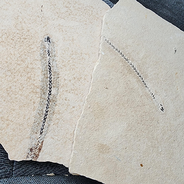
This summer, Wyoming State Geological Survey (WSGS) geoscientists traveled to Kemmerer, Wyoming, to collect a salamander fossil from the Warfield Quarry site located on state lands just south of Fossil Butte National Monument. This exceedingly rare specimen (Paleoamphillma tetradactylum) is one of only three ever found in the Fossil Butte Member of the Green River Formation (GRF), and the only specimen discovered exhibiting delicate soft tissue preservation. The exceptional preservation mechanisms in the Fossil Butte Member of the GRF, along with its wide diversity of specimens—including amphibians, fish, birds, reptiles, mammals, and plants—have puzzled paleontologists for centuries, making it one of Wyoming’s most prolific Lagerstätten deposits. Lagerstättens are sedimentary deposits known for their extraordinary fossil preservation, often capturing fine details such as soft tissues.
|
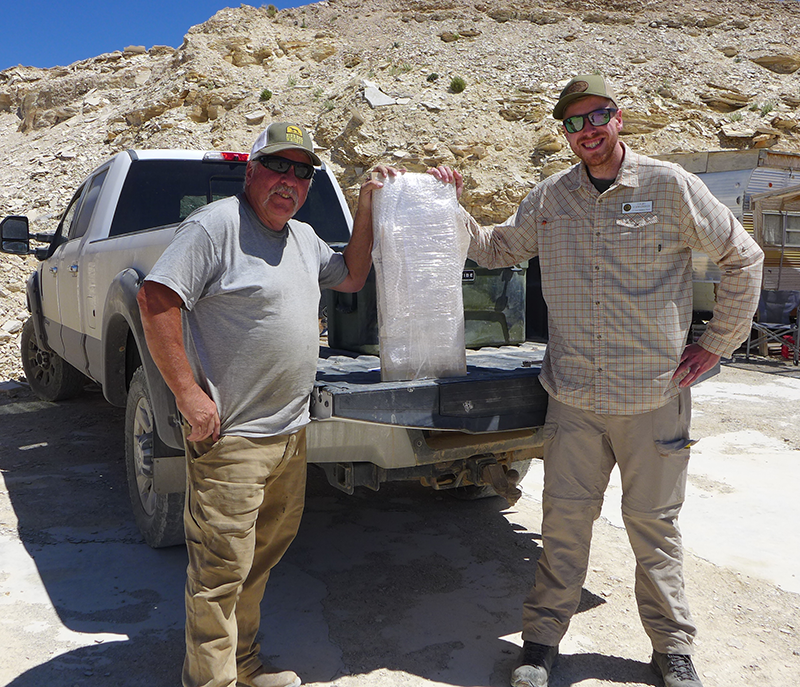 |
Rick Hebdon of Warfield Quarries poses with WSGS scientist Colby Schwaderer and the Paleoamphiuma tetradactylum fossil
This valuable fossil archive offers a unique glimpse into ancient plant and animal communities that lived around Fossil Lake during the early Eocene (~51 million years ago), at a particularly interesting time in geologic history when the Earth was experiencing elevated global warming conditions at the onset of the Early Eocene Climate Optimum (EECO). Rapid climate changes over millions of years can greatly affect water flow, salt levels, sediment build-up, and the communities of organisms living in and around lakes. These impacts are recorded by changes in fine-grained carbonate sediments and the unique fossils preserved within them. With this information, geoscientists can begin exploring why so many different types of fossils are found in significant rock formations, such as the 'Knightia mass mortality layers'—a series of sedimentary deposits known for preserving large numbers of the extinct herring-like fish, Knightia, in a single event. They can also study the unique processes that happen after organisms die—called taphonomic processes—that result in such high rates of fossil preservation in this area.
As a result of the unique fossilization conditions in Fossil Lake, this new salamander discovery may provide new information about the skin and body structure of this extinct member of the Family Sirenidae commonly known as sirens. Modern aquatic salamanders in the Family Sirenidae are elongated and eel-like with reduced limbs, and thrive in warm climates in the southeastern U.S. and in northern Mexico. By comparing the soft tissues and skeletal structures of ancient sirens from the (GRF) to their modern living relatives, paleontologists can learn much about selective pressures and evolutionary trends influencing axial elongation and limblessness observed in modern sirens.
Looking ahead this fall, the WSGS plans to begin work with preparators to stabilize and remove the soft matrix material covering bones and tissues in this specimen. As preparation begins, we hope to share regular updates, photos, and time lapses as we peel back the layers of rock on our social media sites. Once completed this specimen will be stored in the WSGS state fossil archive and will be available for researchers upon request.
Acknowledgment
The Wyoming State Geological Survey would like to extend a special thanks to Rick Hebdon of Warfield Quarries, Dean Sherman of In Stone Fossils, and their dedicated crew members working on state lease lands. Their hard work and commitment made these exceptional fossil discoveries possible, contributing significantly to our understanding of Wyoming’s rich paleontological heritage.
|
|

Liviya Puente joined the WSGS this August as a Senior Accountant. Originally from Cheyenne, Wyoming, Liviya is starting her bachelors in the spring, and she’s always had a love for math and numbers. Outside of work, Liviya enjoys photography, painting, hiking, and exploring new places with her 5-year-old daughter. She’s drawn to Wyoming for its vast outdoor spaces and natural splendor, which provide endless opportunities for adventure and exploration.
Prior to joining the WSGS, Liviya worked as an accountant for the Department of Workforce Services in Cheyenne, where she gained valuable experience managing a range of financial tasks and deepened her understanding of state budgets and financial operations.
What do you do at the WSGS?
"As a Senior Accountant, I manage a wide range of financial responsibilities, from paying bills to managing budgets. Every day is different, and I help ensure that the organization stays financially stable."
What makes your job interesting?
"I’ve always loved working with numbers, and that passion drives my interest in the work I do. I also love the variety my job offers. No two days are the same—there’s always something new to work on or someone new to meet, and that keeps my role exciting and engaging."
How does your job help Wyoming?
"Managing the Survey’s budgets is my top priority. It’s a critical role, and I take that responsibility incredibly seriously. I’m proud to be trusted with such an important task and to contribute to the organization's financial stability."
What are some of your favorite geologic features in Wyoming and why?
"The diverse geologic features are what I love most. The variety of landscapes here is truly special and makes exploring the state an adventure in itself."
|
|
|
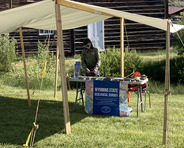
This year, the Wyoming State Geological Survey took part in Gold Rush Days at South Pass City for the first time, joining over 2,800 visitors in celebrating Wyoming’s rich mining history. The event featured everything from gold panning and anvil blasting to reenactments of the Pony Express, bringing the past to life in one of Wyoming’s most historic mining towns.
WSGS played a key role by leading geologic tours of the English Tunnel, a cross-cut tunnel near the famous Carissa Mine. Over the two-day event, WSGS geologists led small groups of visitors from the main town site up to the tunnel—about a mile hike—explaining the regional geology, the significance of South Pass during the Wyoming Gold Rush, and the history of mining in the area. Inside the tunnel, participants had the chance to learn about how miners accessed ore veins and the geology that made the Carissa Mine a hotspot for gold extraction.
|
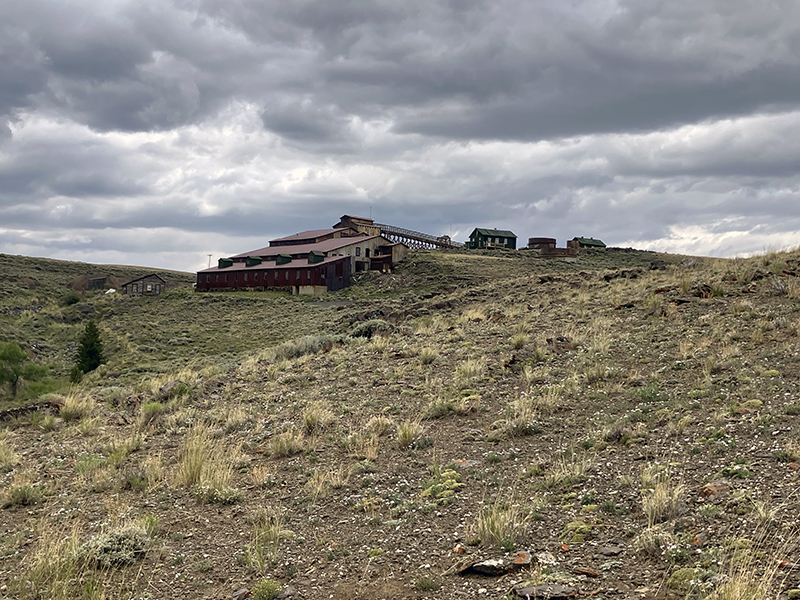
Along with the tours, WSGS hosted a booth filled with geological maps, informational pamphlets, and postcards. Visitors showed particular interest in the new geophysical data from the South Pass-Granite Mountains survey, asking questions about the region’s geology and how it might inform future exploration.
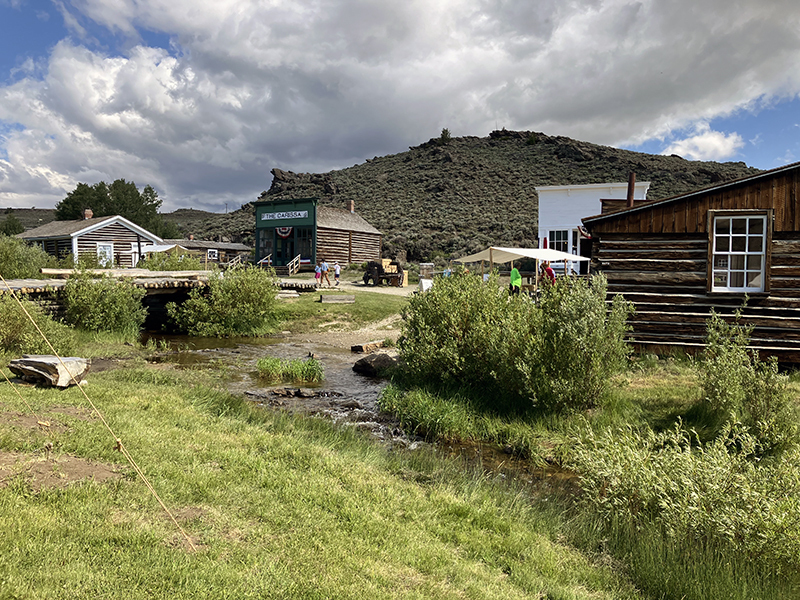
Our team enjoyed engaging with the public, sharing our knowledge of Wyoming’s geology, and connecting with individuals who were excited about the state’s rich mining history.
|
|
|
|
|